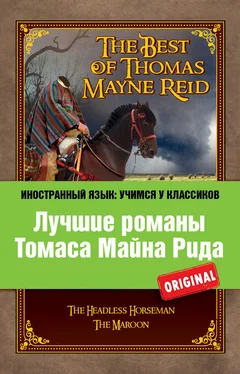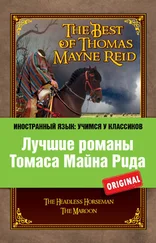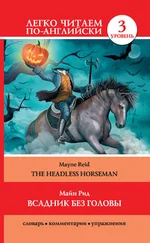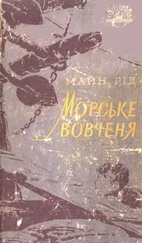The scene chosen for this exhibition was an inner inclosure, or courtyard, contiguous to the dwelling – the great house itself forming one side of this court, and opening upon it by a broad verandah, of a dingy, dilapidated appearance.
Vis-à-vis [483] with the dwelling was another large building which shut in the opposite side of the court – the two being connected by high massive walls, that completed the quadrangle. A strong double gate, opening near the centre of one of these walls, was the way out – that is, to the larger enclosure of the cattle-penn.
From the absence of chimneys and windows, as well as from its plain style of architecture, the building that stood opposite the dwelling-house might have been taken for some large granary or barn. But a peep into its interior at once controverted this idea. Inside could be seen groups of human beings, of all colours, from ebony black to jaundice yellow, in all attitudes – seated, standing, or lying upon the floor – and not a few of them, in pairs, manacled to one another. Their attitudes were not more various than the expressions upon their faces. Some looked sad and sullen; some glanced fearfully around, as if waking from horrid dreams, and under the belief that they were realities; others wore the vacant stare of idiotcy; while here and there a group – apparently regardless of past, present, or future – chattered in their barbaric language with an air of gaiety that bespoke the most philosophic insouciance .
The building that contained them was the baracoon – the storehouse of the slave-merchant. Its occupants were his stores!
The “stock” had been just replenished by the cargo of the slave-ship, though there were also some old “bales” on hand; and these were in the act of entertaining the new comers, and initiating them into the ways of the place. Their means, of showing hospitality had been limited – as testified by the empty calabashes [484] and clean-scraped wooden platters that lay scattered over the floor. Not a grain of rice, not a spoonful of the pepper-pot, not a slice of plantain, was left. The emptiness of the vessels showed that the rations had been as short as the viands were coarse and common.
Outside, in the yard, were many groups, happier to escape from the stifled atmosphere of their crowded quarters; though that was freedom when compared with the ’tween-decks of the middle passage .
Each group was gathered around some old hand – some compatriot who had preceded them across the great sea – and who, himself initiated into slavery under a western sky, was giving them some notions of what they had to expect. Eager looks of all, from time to time, directed towards the verandah, told that they were awaiting some event of more than ordinary interest.
There were white men in the courtyard – three of them. Two were of dark complexion – so swarth that many of the coloured slaves were as fair-skinned as they. These two men were lounging by the stairway of the verandah – one of them seated upon the steps. Both were sparely clad in check shirts and trousers, having broad-brimmed palmetto hats on their heads, and rough buskins on their feet and ankles.
Each carried a long, rapier-like blade – a machete – hanging over his hip in its leathern sheath; while a brace of fierce dogs – looped in cotton-rope leashes, attached to belts worn around their waists – crouched upon the ground at their feet.
The faces of these men were clean-shaven – a pointed chin-tuft, or “bigote,” alone being left; and the hair on the heads of both was close-cropped. Their sharp, angular features were thus fully displayed, denoting a high order of intelligence; which might have produced a pleasing effect, but for the pronounced expression of cruelty which accompanied it.
The exclamations that from time to time escaped from their lips, with the few words of conversation that passed between them, bespoke them of Spanish race. Their costume – their arms and accoutrements – their comrades, the fierce dogs – plainly proclaimed, their calling, as well as the country from whence they came. They were caçadores de negros – negro-hunters from the Island of Cuba.
The third white man who appeared in the courtyard differed essentially from these – not so much in colour, for he was also of swarth complexion – but in size, costume, and calling. A pair of horse-skin riding-boots reached up to his thighs, on the heels of which appeared heavy spurs, with rowels three inches in diameter. A sort of monkey-jacket of thick cloth – notwithstanding its unsuitableness to the climate – hung down to his hips; under which appeared a waistcoat of scarlet plush, with tarnished metal buttons, and a wool comforter of the same flaming colour. Crowning all was a felt hat; which, like the other articles of his dress, gave evidence of exposure to all weathers – sun and rain, storm and tornado.
A thick shock of curling hair, so dark in colour as to pass for black; a heavy beard, jet-black, and running most of the way around his mouth; amber-coloured eyes, with a sinister, shining light that never seemed to pale; lips of an unnatural redness gleaming through the black beard; and a nose of aquiline oblique, were the points in the personal appearance of this man that most prominently presented themselves.
The effect of this combination was to impress you with the conviction, that the individual in question belonged to the same nationality as the proprietor of the penn. Such was in reality the case: for the bearded man was another of the race of Abraham [485] , and one of its least amiable specimens. His name was Ravener, his calling that of overseer: he was the overseer of Jessuron. The symbol of his profession he carried under his arm – a huge cart-whip. He had it by him at all hours – by night, as by day – for by night, as by day, was he accustomed to make use of it. And the victims of his long lash were neither oxen nor horses – they were men and women !
No sparing use made he of this hideous implement. “Crack, crack!” was it heard from morn to eve; “crack, crack!” from eve to midnight; if need be, from midnight to morning again: for some said that the overseer of Jessuron never slept. “Crack, crack!” did he go through the courtyard, apparently proud of exhibiting his power before the newly-arrived negroes – here and there swinging his long bitter lash among the groups, as if to break up and scatter them in sheer wantonness.
Chapter 21
A Fiery Baptism
It was about twelve o’clock in the day. Jessuron and his daughter had just stepped forth into the verandah, and taken their stand by the balustrade looking down into the court. The countenance of both betrayed a certain degree of solicitude, as if they had come out to be witnesses to some spectacle of more than common interest.
The house-wenches and other domestics, trooping behind them with curious looks, showed that some rare scene was to be enacted.
A small iron furnace, filled with live coals, had been placed in the courtyard, near the bottom of the steps. Three or four sullen-looking men – blacks and mulattoes – stood around it in lounging attitudes. One of these stooped over the furnace, turning in the fire what appeared to be a soldering iron, or some other instrument of a brazier.
It was not that, however, as the spectators well knew. All who beheld it recognised the dreaded branding iron : for every one present, the whites and newly-arrived Africans excepted, had, ere now, felt its hot, seething fire in their flesh.
These last had already learnt what was preparing for them; and most of them stood regarding the preparations with looks of silent awe.
Some Coromantees there were among the number, who looked on with reckless indifference, chatting as gaily – and, at intervals, laughing as loudly – as if they awaited the beginning of some merry game. Little cared these courageous sons of Ethiopia – whose sable skins bore scars of many a native fray – little cared they for the scorching of that simple brand.
Читать дальше
Конец ознакомительного отрывка
Купить книгу











